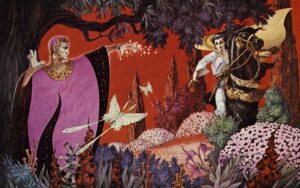Warring for Peace: Testing Justice in The Dying Earth
By Efe Bir

Jack Vance’s “The Dying Earth” consists of a series of fantasy short stories set in a post-apocalyptic world where the Sun is on the brink of extinction and magic reigns as the primary source of power. Although the six stories in the book may appear impenetrable for a values analysis due to their high fantasy nature and intricate world-building, they all touch upon significant themes that underscore the importance of certain values. Particularly, the first three interconnected stories—”Turjan of Miir,” “Mazirian the Magician,” and “T’sais”—provide a compelling illustration of the overarching value of justice in society.
The opening story, “Turjan of Miir,” establishes the foundation for what I will refer to as the two realms of values. We follow the wizard Turjan on his journey from Earth to the realm of Emblyon, where he seeks to study under the tutelage of the powerful sorcerer Pendelume. During his time in Emblyon, Turjan acquires knowledge in the creation of artificial life and encounters T’sais, Pendelume’s flawed creation burdened by loneliness. In an effort to alleviate her isolation, Turjan creates a twin named T’sain. In the subsequent story, “Mazirian the Magician,” T’sain sacrifices herself to save Turjan from the clutches of Mazirian, a greedy and cruel magician from Earth who seeks to imprison Turjan and extract Pendelume’s wisdom. The third story, “T’sais,” delves into the contrasting values of Earth and Emblyon. T’sais, plagued by her flawed mind that prevents her from experiencing beauty in Emblyon and inclines her towards violence, embarks on a quest to Earth in search of joy and beauty. However, her encounters in Mazirian’s tale and Pendelume’s warning about Earth’s materialistic values, as opposed to Emblyon’s pursuit of knowledge, prove inadequate. T’sais arrives on Earth only to encounter injustice and a profoundly wretched society. As she strives to find joy and beauty without resorting to violence, she becomes entangled in a cycle where she must pursue justice and employ violence in a dying world devoid of motivation.
These three stories gradually lead the reader, alongside T’sais, to the realization that in order to establish a non-violent and just society, T’sais must confront and struggle against the violent resistance she encounters, even if it means embracing the need for violence within herself that she had previously attempted to suppress in Emblyon. This exploration of justice and its teachings in the text poses a fundamental question: What should an individual do when their pursuit of justice is met with vehement opposition?

